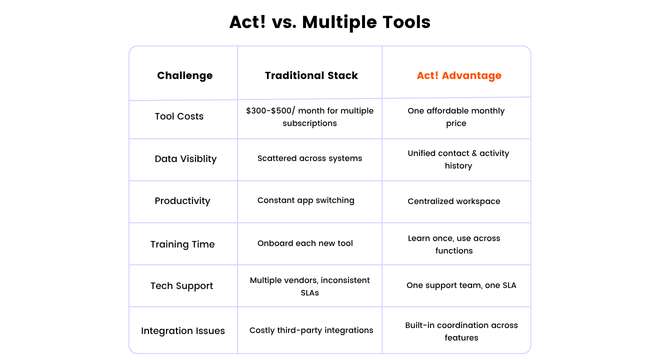
As your small business grows, so does the number of systems or tools that you use. A separate platform for email, another for CRM, a plugin for lead capture, a scheduling platform, and tools for surveys and project tracking. Individually, these platforms solve specific challenges. Combined, they often create complexities, cost overruns, inefficiency, and data silos. The question you should be asking is: How many systems and disconnected tools are you paying for? And is this sustainable?
The Cost and Complexity of Tool Sprawl
Rapid Expansion of SaaS Use
SaaS adoption is accelerating. According to BetterCloud, mid-market and enterprise organizations recently averaged 130 SaaS applications—an 18% increase since 2022. SMBs with fewer than 200 employees still manage 42 different SaaS apps on average. These numbers continue to rise, reflecting a growing reliance on digital tools.
Hidden Monthly Costs
Even on conservative estimates, fragmenting your toolset incurs real expenses:
- Email marketing platforms can cost between $0–$99/month for tools managing 5,000 contacts. Agency-managed campaigns often incur $300–$500/month.
- CRM solutions typically start around $10/user/month, with fully-featured plans approaching $67–$100/user/month
- Lead-capture and survey tools, like Typeform or SurveyMonkey, can add $15–$50/user/month.
- Appointment scheduling tools, such as Calendly or Acuity, average $10–$20/month.
- Project management solutions (e.g., Trello or Asana) often cost $10–$30/user/month.
Altogether, this fragmented tech stack can easily amount to $150–$400+/month per user, excluding onboarding, integrations, or training time.
Efficiency and Data Challenges
Using multiple tools also erodes operational efficiency:
- Context switching slows productivity and increases error risk.
- Data fragmentation creates siloed customer views and inconsistent reporting.
- Training demands escalate with every new system, while ongoing technical overhead drains resources.
The result is an ecosystem where nominally helpful tools, when combined, stunt productivity and inflate cost.
Act! Advantage: One Platform, Full Control – No More Disconnected Tools

Act! Advantage was born from this challenge. It offers a unified suite—CRM, email marketing, scheduling, surveys, lead capture, and project tracking—under a single solution. Instead of paying multiple subscriptions and coordinating logs across platforms, businesses get:
- Centralized contact & company databases
- Integrated web forms and survey creation
- Automated email and SMS marketing
- Seamless scheduling and workflow coordination
- Project and task management
- Custom dashboards for real-time insight
By consolidating these functions, Act! Advantage dramatically reduces cost complexity and operational friction. You gain one vendor, one login, and one consistent workflow across your entire customer lifecycle.
Conclusion
Many businesses begin with a lean tech stack; over time, fragmenting tools and multiple subscriptions unintentionally erode control, inflate costs, and complicate growth.
Ask yourself:
- How many tools and subscriptions do I currently manage?
- What overhead—training, integration, data reconciliation—is buried in this stack?
- Could my team be more productive and cost-effective with a unified system?
For SMBs seeking to streamline operations, reduce overhead, and reclaim productivity, Act! Advantage unites all of your disconnected tools and delivers a smarter, more sustainable solution.





